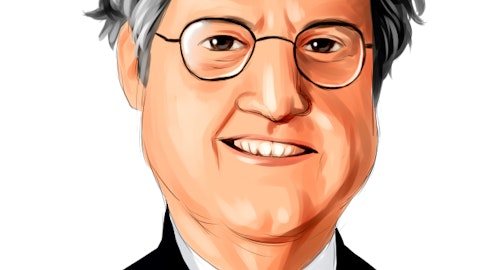Freeport-McMoRan Copper & Gold Inc. (NYSE:FCX) reported a weak third quarter today, with copper sales volumes declining 3% and the company’s overall revenues falling by 15%. With production costs being high, margins declined as well and so net income was down 22% from the third quarter of 2011. Freeport McMoRan’s gold sales were also down, contributing to the poorer bottom line. Investors follow the company because copper demand is particularly sensitive to global growth, and so its results serve as something of an economic indicator. The stock is now up only 3% year to date, trailing the broader market indices.
Freeport-McMoran Copper & Gold Inc. suggested in its quarterly report that copper volumes would be up again in 2013, which would leave the company well prepared for stronger copper prices in the event that growth (particularly in China) gets back on track. The market capitalization of about $38 billion places Freeport McMoRan at 8 times forward earnings estimates, suggesting that investors have limited growth expectations. It could also be the case, of course, that macro concerns are pulling capital away from a stock with such exposure to the broader economy (the beta is 2.3). At current prices, Freeport McMoRan does pay a dividend yield of 3.0%, but we think that any bull case would have to depend on decent output numbers next year which at least hold prices steady and allow the company to hit its earnings targets.
One fund which was bullish on Freeport-McMoRan Copper & Gold Inc. during the second quarter was Adage Capital Management; Adage more than tripled the size of its position between April and June and reported ownership of 2.7 million shares in its 13F filing. Adage is managed by former Harvard Management investors Phil Gross and Robert Atchinson (see more stock picks from Adage Capital Management). Billionaire Ken Fisher’s Fisher Asset Management also liked the stock, owning 14.1 million shares at the end of June (find more stocks that billionaire Ken Fisher likes). D.E. Shaw, whose founder David Shaw is now a billionaire due to the large hedge fund’s success, cut its stake but still owned 2.1 million shares at the end of the quarter (research more stocks D.E. Shaw has been buying or selling).
Southern Copper Corp (NYSE:SCCO) and Sterlite Industries India Limited (NYSE:SLT) are two peers in the copper mining industry. Southern Copper, about the same size in terms of market cap, carries a forward P/E of 15. In the second quarter, its revenue and earnings were down compared to the same period in 2011 (with net income down by 14%), better numbers than Freeport McMoRan had done over the same time period. Still, we are skeptical that it deserves such a high premium. Sterlite’s market cap of just over $6 billion makes it considerably smaller. Its second quarter had actually shown better revenue, but its earnings were down substantially. At 10 times trailing earnings, it looks to be priced at about the same multiple as Freeport McMoran despite its smaller size.
As for peers in gold mining, we would compare Freeport McMoRan to Newmont Mining Corp (NYSE:NEM) and Barrick Gold Corporation (NYSE:ABX). These companies have considerably lower betas, less than 0.3 in each case; while less sensitive to global growth, they are of course dependent on gold prices. The sell-side is very optimistic in the case of Newmont, expected to improve from barely profitable this year to a forward P/E of 11 and a five-year PEG ratio of 0.3 despite a recent decline in its business. We would avoid it. Barrick at least has some standing to be considered a value play, as it trades at trailing and forward P/E multiples of 10 and 8, respectively. Its earnings were 35% lower in the second quarter than in Q2 2011, but its downside should be limited by a relatively low valuation.
Freeport McMoran and Barrick are risky in the sense that they are tied to copper and gold demand, respectively. They do carry somewhat cheap valuations relative to similar companies, and could be good be good picks if an investor is bullish on those commodities but would like to avoid investing in them directly.






